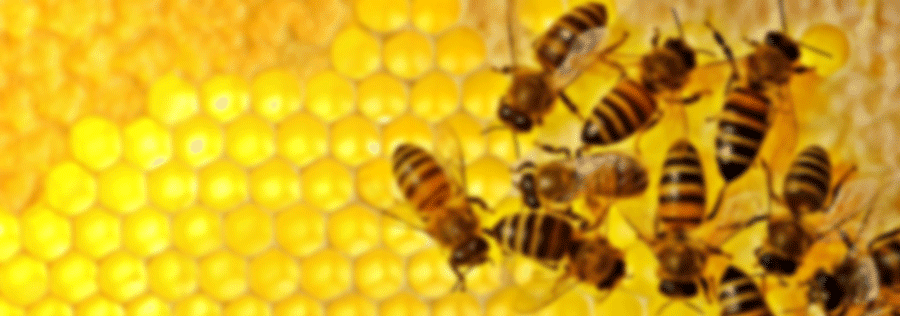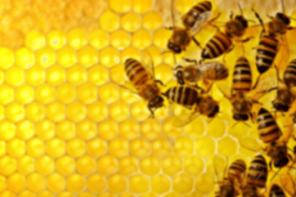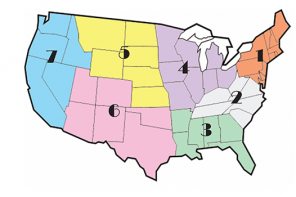Minerals And The Bees’ Needs
Rachael Bonoan and colleagues at Tufts University have been studying the impacts of salt and other minerals on honey bee health for several years. This work is spurred by historical observations that honey bees often choose murky water sources over pristine ones, arguably reflecting a search for resources that are scarce in pollen and nectar. Writing in Ecological Entomology (http://onlinelibrary.wiley.com/doi/10.1111/een.12375/pdf), the authors describe a clever bee ‘cafeteria’ used to build the case that bees on water foraging trips can identify minerals and selectively drink those waters highest in specific minerals, from salts to calcium. Their results hint at a seasonal shift in forager preferences for specific minerals coinciding with changes in pollen availability and consumption. While more could be done to determine whether bees actively search out specific minerals or are simply less choosy in certain times of the year, the results do suggest that water-collecting bees, like those foraging for pollen or nectar, are somehow driven by the hive mind.
Pierre Lau and James Nieh in San Diego took a lab-based approach to address similar questions (doi:10.1242/jeb.132019). Their study relied on a behavioral technique widely used for everything from age-based learning to measuring the impacts of pesticides on bees. They used this technique, the Proboscis Extension Reflex (PER), to determine the concentrations at which worker bees favor or avoid minerals found in water. They, too, showed a general preference for salty water, at concentrations far higher than levels observed in nearby water sources. Interestingly, individual bees from the same hive differed greatly in their desire for salt. In statistical terms, the salt preferences among bees from the same hive were far more variable than were average differences across hives. This result suggests that current nutritional status for those bees, past foraging experiences, or even genetics, can impact the desire for salt and other minerals. These authors also found that minerals both attracted and repelled worker bees. As an applied output for this result, the authors suggest that bees could be warned off from toxic waters if these waters were also marked with high levels of repellent minerals such as potassium.
Both studies provided a happy opportunity to revisit the elegant and practical nutrition research of Dr. Elton Herbert, Jr., a USDA-Beltsville honey bee scientist in the 1970s and early 1980s who died too young. Herbert was conversant in all components of the honey bee diet and used a series of experiments to test the favorability of minerals for bee health. In developing what would become the ‘Beltsville bee diet’, he and Hachiro Shimanuki showed that a mid-range level of minerals in an artificial bee diet led to greater growth than did low- or high-salt mixes (http://dx.doi.org/10.1080/00218839.1978.11099916). He also tested the impacts of pollen-based versus ‘mined’ minerals on bee health (http://dx.doi.org/10.1080/00218839.1979.11099958), showing that pollen ash derived from a custom blend of pollens led to the strongest brood growth when compared to a low-mineral diet or one supplemented with Wesson’s salt, a product with >10X as much sodium. In contrast to the recent studies, bees were LESS likely to consume mineral-rich diets versus control diets lacking those minerals.
Supplementing a plant-based diet with alternative sources of minerals is of course not limited to bees. Butterflies and other insects routinely collect minerals from puddles and other impure water sources. Similarly, entire industries have been built around efforts to attract and/or sustain salt- or mineral-crazed domestic and free-living mammals. In an analogous ‘cafeteria’ study, Jose Estevez and colleagues in Spain showed that deer change their preferences for several minerals across seasons, reflecting their needs (DOI: 10.1071/AN09012). Similarly, Pablo Gambín and colleagues showed that red deer engage in ‘osteophagia’, or the consumption of antlers and bones, during seasons when calcium needs are highest (DOI 10.1007/s10344-017-1095-4). As a further extreme, deer and other large grazers occasional harvest living animals, feeding on their skeletons when the available forage does not provide enough calcium. As with the honey bees, studies of mammalian feeding behavior have led clever researchers to new insights into dietary needs and new recommendations for increased growth. Hopefully this work will further improve the many artificial diets and supplements available for honey bees.
Jay Evans is the Research Leader for the USDA Honey Bee Lab in Beltsville, MD.











